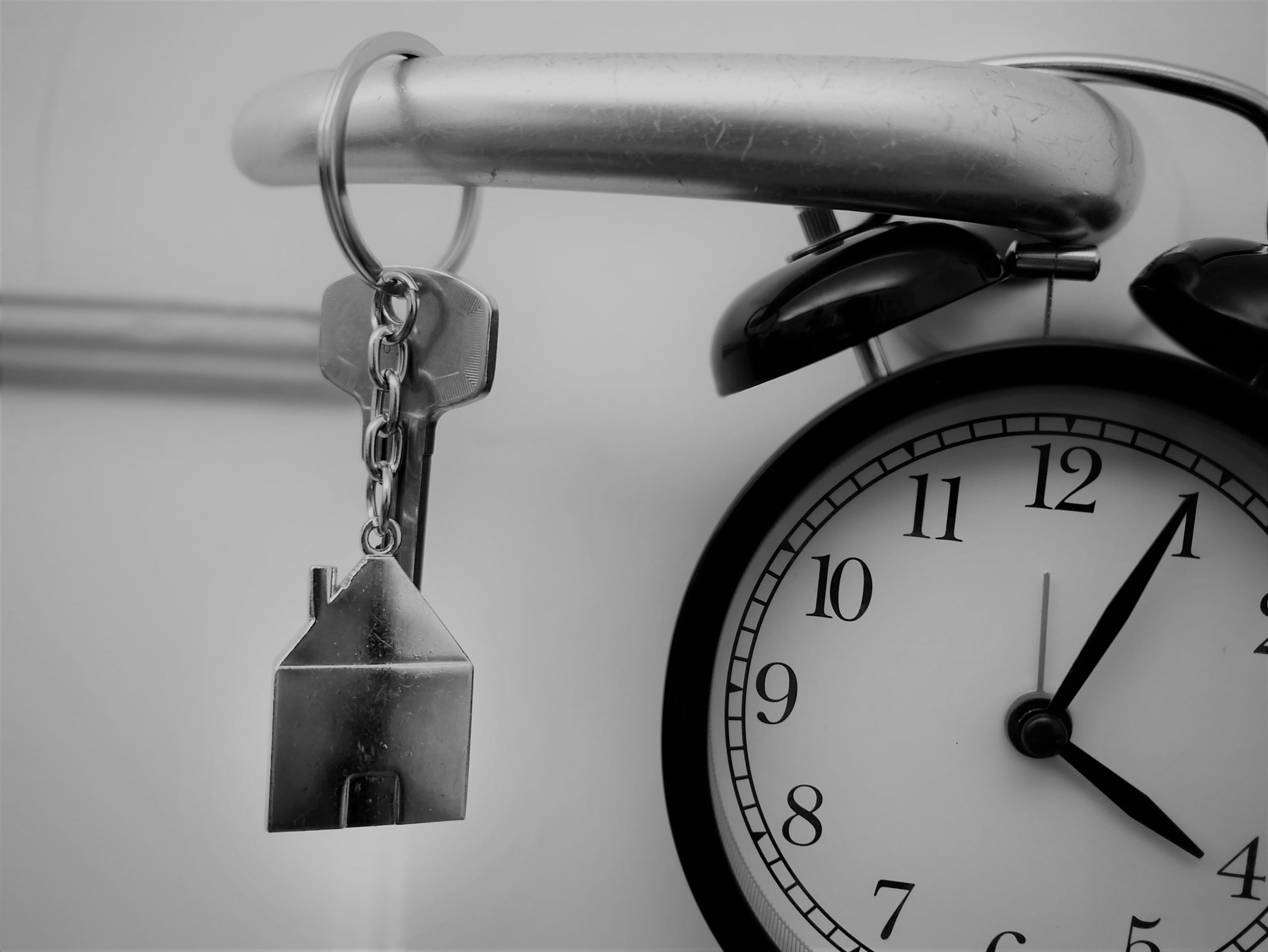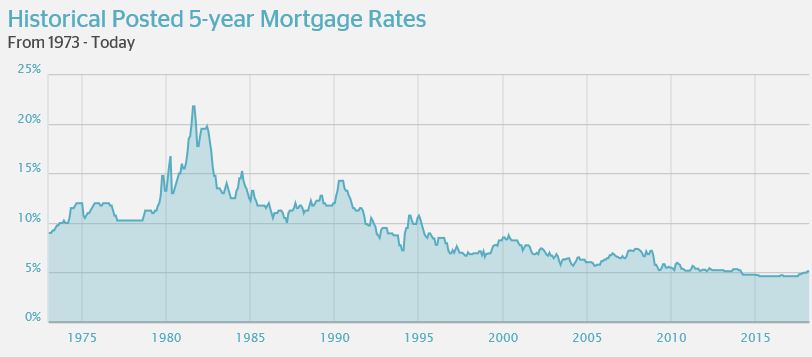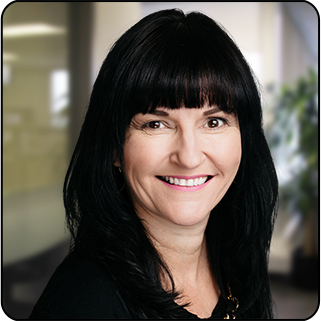Throwback: A Look at 5-Year Fixed Mortgage Rates & Where We’re Headed

Mortgage rates have been steadily declining to historical lows since 2008 and it goes without saying, we’ve all benefited from paying interest with pocket change. But like all good things, nothing lasts forever. Rate increases have been brewing for a long time and the longer it goes on, the more havoc it plays on the psyche of today’s homeowners.
Historical five-year mortgage rates (1973 – 2017)

Look back at 5-year fixed rates between 1976 to 2017
If you asked us about our mortgage rates now, compared to when we first started in the financial industry, you would get a very different answer. In 1997, Bridgewater Bank, previously Pafco Mortgage Co., wrote its first mortgage. Back then, the interest rate for a conventional five-year mortgage was around seven percent – with rates like that, you wonder how people could afford houses.
Also read: Why Mortgage Payments Matter More Than Mortgage Rates
Times have changed over the last 20 years. Rates may have decreased, but cost of living hasn’t and certainly not property prices. To gain a better perspective of this evolution, we thought it would be beneficial to ask people around the office about their first mortgage.
As mortgage rates potentially reach their floor, Bridgewater Bank employees remember their first mortgages from rates as high as 9.75 in 1976 to rates as low as 3.25 in 2010.
When rates were 9.75-percent 1976
“Times were different back then,” recalls Dave Terletski, Director, Enterprise Risk Management, “owning a home was a privilege.” Terletski purchased his first home in 1976 in Edmonton. At that time, he took out a $59,000 mortgage on his new condo with a fixed interest rate of 9.75-percent, 25-year amortization. “You really must look at the cost of living now and then, it’s all relative,” he adds, “back then, fixed rates were all that there was.” Terletski suggests borrowers today evaluate their financial position to see what type of rate they can afford.
Disposable income offers opportunity for flexibility, whereas a fixed payment also carries benefits. As Terletski advanced in his career in the financial industry and observed rate changes firsthand, he quickly learned what type of mortgage would fit him best based on his financial plan and position.
When rates were 9.5-percent in 1992
Similar to Terletski, the Bank’s director of service and operations, Scott Sanders, purchased his first home in Thunder Bay, Ont. in 1992. “$60,000 was a lot of money back then,” Sanders adds when discussing his first mortgage.
With a five-year insured mortgage, Sanders got an interest rate of 9.5-percent – not dissimilar to 1976. It wasn’t till the late 90s and early 2000s that the market saw a decrease in rates.
When rates were 6.25-percent in 1999
Jason Provencher, Manager, B2B Solutions, purchased his first home in Edmonton in 1999. He may have received a lower rate of 6.25-percent, but the $120,000 loan he took out compensated for that advantage. “It was almost like I was house poor,” revealed Provencher.
When evaluating mortgage options, he chose a five-year fixed term and opted to use his 20/20 prepayment privileges – a smart move if you have the income. “It’s your first house, so you’re excited,” he recalls while taking a look back at his first mortgage.
Related: 5 Part Guide – The Mortgage Process & How To Get Approved
When rates were 4.15-percent in 2007
The 2000s produced low interest rates, never seen in Canadian history. In 2007, Liz Elliott, Product Manager, purchased a condo in downtown, Calgary with a variable, 40-year amortization loan at prime minus 0.60 percent with a rate of 4.15-percent. By Oct. 9, 2007, her rate dropped to 3.9-percent, followed by 2.9-percent in December 2008.
By March 2009, it had decreased and settled at 1.9-percent. Working as a mortgage broker at the time, Elliott saw a lot of borrowers prepaying their fixed loans to switch to a lower rate mortgage, “Even with the prepayment penalty borrowers were coming out ahead,” Elliott shares.
When rates were 3.25-percent in 2010 (and 2.95-percent in 2017)
The final interviewee, also the most recent home buyer is Jackie Ollivier, Marketing Communications Advisor, who purchased her home in Calgary in 2010. Her loan of $388,000 with a five-year fixed rate of 3.25-percent goes to show that ‘times have certainly changed.’ Five years later, her rate dropped to 2.64-percent. “It was easier to buy this huge purchase than I thought,” she expresses, “it was the best investment I have ever made.”
Where are 5-year fixed mortgage rates headed?
The evolution of mortgages has led to some prevalent extremes. What was a large sum of money back then, is nowhere near market prices today. Rates are ever changing and this year’s potentially starting to climb. The Bank of Canada raised its benchmark interest rate in July for the first time in seven years, leading mortgage lenders to increase prime lending rates to 2.95-percent from 2.70-percent. Another 25bps increase is expected in October 2017.
Also read: Open vs Closed Mortgages – What a Client Needs to Know
That increase won’t come to us as a surprise, but it sheds light on why some borrowers opt for a mortgage rate that is fixed for the term of the mortgage. It’s a popular option for clients seeking the security of a set mortgage payment. This type of rate is primarily influenced by bond yields (a type of investment that guarantees the principal and interest payment by the Canadian government).
Takeaway: will rates go up?
Although interest rates may be higher in the future compared to the current lows today, it seems unlikely that we’ll see rates anywhere near as high as they were in the 1970s. Many would consider the 0.25 percent rate increase as a warning signal to mortgage holders.
Rates are likely to continue to increase, but slow and steady over time. As a broker, your clients rely on your advice to ensure they have the right mortgage product at the best rate. “It’s about planning for their family and seeing what options are available for their needs,” Terletski says.
We’re all sentimental about our first mortgage, join us in sharing your story about the first mortgage you worked with. Let us know what was your advice on the first mortgage you wrote.









